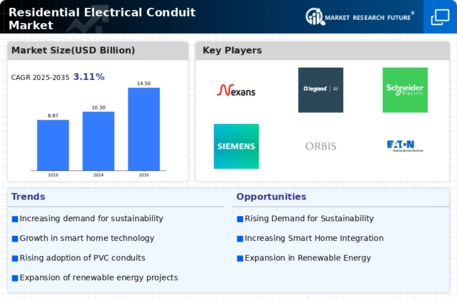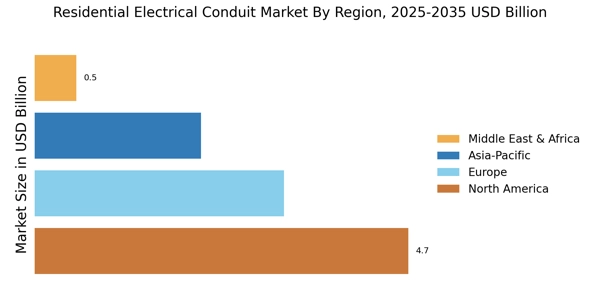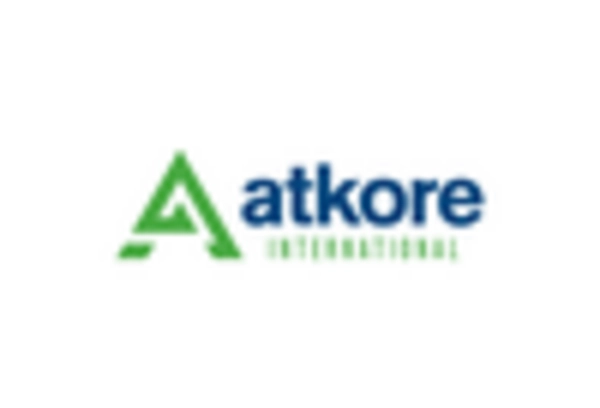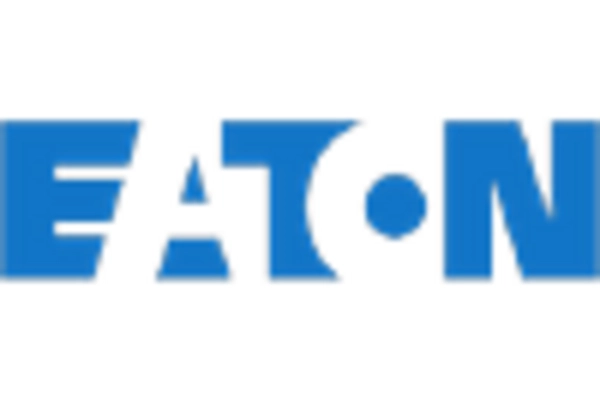Growing Awareness of Energy Efficiency
The growing awareness of energy efficiency is a key driver in the Residential Electrical Conduit Market. Homeowners are increasingly seeking solutions that reduce energy consumption and lower utility bills. This trend has led to a heightened interest in electrical systems that utilize conduits designed for optimal energy efficiency. Recent studies suggest that energy-efficient homes can reduce energy costs by up to 30%, making them attractive to consumers. As a result, manufacturers are focusing on developing conduits that support energy-efficient electrical installations. This shift not only benefits homeowners but also aligns with broader environmental goals, as energy-efficient systems contribute to reduced carbon footprints. The Residential Electrical Conduit Market is thus likely to see a rise in demand for products that promote energy efficiency.
Regulatory Compliance and Safety Standards
The Residential Electrical Conduit Market is significantly influenced by stringent regulatory compliance and safety standards. Governments and regulatory bodies are continuously updating electrical codes to enhance safety in residential buildings. This has led to an increased emphasis on using high-quality conduits that meet these standards. For instance, the National Electrical Code (NEC) outlines specific requirements for conduit installations, which manufacturers must adhere to. As a result, the demand for compliant products is on the rise, pushing manufacturers to innovate and improve their offerings. The market is expected to see a shift towards conduits that not only meet safety standards but also offer additional features such as fire resistance and durability, thereby enhancing the overall safety of residential electrical systems.
Rising Demand for Residential Construction
The Residential Electrical Conduit Market is experiencing a surge in demand due to the increasing number of residential construction projects. As urbanization continues to expand, more homes are being built, necessitating the installation of electrical systems that require conduits for safety and efficiency. According to recent data, the residential construction sector has shown a steady growth rate of approximately 5% annually, which directly influences the demand for electrical conduits. This trend is expected to persist as more homeowners prioritize modern electrical installations that comply with safety regulations. Consequently, manufacturers in the Residential Electrical Conduit Market are likely to benefit from this growing demand, leading to innovations in conduit materials and designs to meet the evolving needs of the construction sector.
Sustainability Trends in Construction Materials
Sustainability trends are increasingly shaping the Residential Electrical Conduit Market. As environmental concerns gain prominence, there is a growing demand for eco-friendly materials in construction, including electrical conduits. Manufacturers are responding by developing conduits made from recycled or sustainable materials, which appeal to environmentally conscious consumers. Recent data indicates that the market for sustainable building materials is expected to grow at a rate of 10% annually. This trend is likely to drive innovation within the Residential Electrical Conduit Market, as companies strive to create products that not only meet performance standards but also align with sustainability goals. The shift towards sustainable materials is expected to enhance the market's appeal and foster a more environmentally responsible approach to residential construction.
Technological Advancements in Electrical Systems
Technological advancements are playing a pivotal role in shaping the Residential Electrical Conduit Market. The integration of smart home technologies has led to a greater need for efficient electrical systems, which in turn drives the demand for high-quality conduits. As homes become increasingly equipped with smart devices, the complexity of electrical installations rises, necessitating the use of advanced conduit solutions. Recent statistics indicate that the smart home market is projected to grow at a compound annual growth rate of 25% over the next five years. This growth is likely to propel the Residential Electrical Conduit Market forward, as manufacturers adapt their products to accommodate the sophisticated requirements of modern electrical systems.


















Leave a Comment